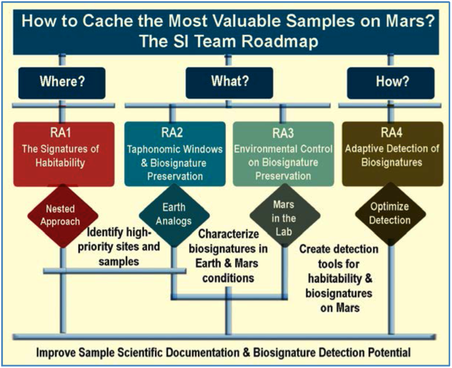SETI Institute
01/2015 -
12/2019
(CAN 7)
Changing Planetary Environments and the Fingerprints of Life
The SETI Institute (SI) team is developing a roadmap to biosignature exploration in support of NASA’s decadal plan for the search for life on Mars – with the Mars 2020 mission providing the first opportunity to investigate the question of past life on Mars. In an ancient Mars environment that may have once either supported life as we know it, or sustained pre-biological processes leading to an origin of life, the Mars 2020 mission is expected to be a Curiosity-class rover that will cache samples for return to Earth at a later date. The SETI team will address the overall question “How do we identify and cache the most valuable samples?”. One of the greatest uncertainties in this question is the role that the unique early martian environment may have played in habitability, the formation of organic molecules, and the preservation of biosignatures. Understanding how a biogeological record was transformed through the loss of atmosphere, increased biologically-damaging ultraviolet (UV) radiation, cosmic rays, and chaotically-driven climate changes is, therefore, the key to unlocking (1) where to search for the right rocks on Mars, (2) what to search for, and (3) how to search for them. These are the three fundamental sub-elements of the SETI team’s research.
Their research program employs an integrated exploration approach that extends the search for the most valuable samples from orbit to the molecular scale. The effectiveness of this approach is evaluated in key early Mars analogs at terrestrial sites and in the laboratory. While their work is directly aimed at supporting a Mars 2020-type mission, the overarching goal is much broader and intended to develop a roadmap to biosignature exploration for Mars. Their roadmap is to produce the fundamental guiding principles of an exploration strategy that, ultimately, will help NASA return the most valuable martian samples to Earth.
Planetary Lake Lander video series. The entire series is available here.
The research program of the SETI team is organized around four Research Areas (RA), each addressing a crucial facet of their central question. Within them, Focus Areas regroup investigations that synergistically tackle key aspects of habitability, biosignatures, and exploration in order to optimize the scientific documentation and detection potential of high-priority samples. Research Area 1 will produce mega- to mesoscale surveys extending from orbit to the surface of martian regions and terrestrial analog sites dominated by aqueous mineralogy. These surveys will utilize similar methods and datasets for both planets. On Earth, their analyses of aerial imagery will seek to identify intermediate scales and resolutions that constitute diagnostic thresholds not yet available by revealing contextual attributes that can be successfully, and repeatedly, linked to the presence of high-priority biogeomaterials. High-priority study areas for in-depth field investigations will be designated through this approach.
Research Area 2 will explore the designated areas from mesoscale to textural microscale. Investigations will use in situ field instruments relevant to the programmatic measurements identified to efficiently characterize the geology of a site, assess habitability, select samples, and document sample context. Areas explored reflect the high-priority environments identified by the Mars 2020 Science Definition Team and are regrouped into four Focus Areas: volcanic/hydrothermal, lake sediments, evaporites, and perennial cold springs. Correlated measurements, scientific documentation, and field data will allow the team to define taphonomic windows, i.e., the sedimentary and diagenetic circumstances conducive to biosignature preservation and will support the down-selection of samples to be returned for state-of-the-art lab analyses.
Research Area 3 will experimentally examine at molecular scales synthetic and natural samples returned from the field. Coordinated lab investigations will characterize the individual and combined role played by water, minerals and soil matrices, UV, and cosmic rays on organic preservation potential. The results of these lab studies will be used to evaluate the effectiveness of the approach in detecting high-priority biogeomaterials, establish mechanistic differences in Mars analog (field) and simulated (lab) biosignature processing, and develop exploration methodologies aimed toward the rapid identification of sample targets for in situ astrobiological investigations.
Research Area 4 will further advance biosignature identification by applying data fusion, novelty detection, and autonomous detection of biogenicity across the RA1-3 datasets. These databases and samples will be made available to the NASA Astrobiology Institute (NAI) teams and then to the larger scientific community. It will fill essential gaps in lab-field-orbital technology and will directly support a decade of searching for life on Mars. Scientifically, the SETI team will i) characterize terrestrial analogs of high-priority environments and biogeomaterials essential for identifying traces of ancient life on Mars, and ii) investigate the impact of changing early martian conditions on the preservation of biosignatures. By examining the physical, biomolecular, and metabolic records of life in these environments, their research program will also, iii) define their habitability potential, taphonomic windows, potential for biosignatures and their preservation potential. In technology develoment, the team will i) concurrently advance the understanding of instruments providing data on threshold and baseline measurements requested by the Mars 2020 SDT to satisfy the scientific documentation of high-priority samples, and ii) evaluate their individual and combined diagnostic power on key Mars analog materials. Methodologically, we will synergistically investigate environments and biogeomaterials at multiple scales to support, ground-truth, and validate results every step of the way.

-

Nathalie Cabrol

-
Active Dates:
01/2015 - 12/2019 -
Team Website:
Coming Soon -
Members:
50 (See All)




